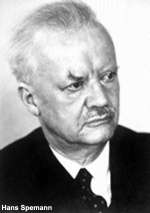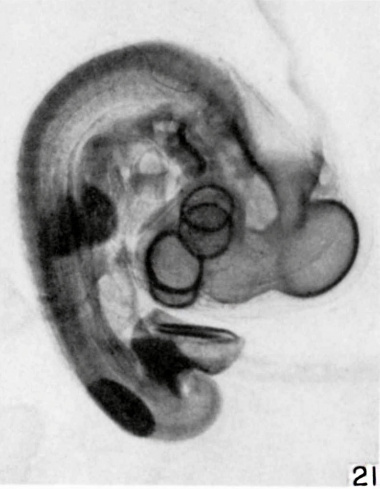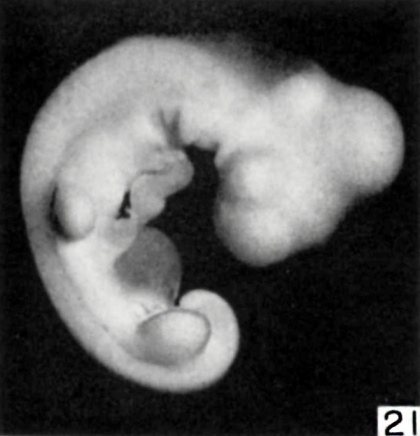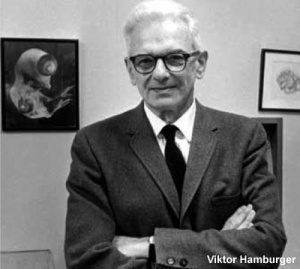Embryology History - Viktor Hamburger
| Embryology - 27 Apr 2024 |
|---|
| Google Translate - select your language from the list shown below (this will open a new external page) |
|
العربية | català | 中文 | 中國傳統的 | français | Deutsche | עִברִית | हिंदी | bahasa Indonesia | italiano | 日本語 | 한국어 | မြန်မာ | Pilipino | Polskie | português | ਪੰਜਾਬੀ ਦੇ | Română | русский | Español | Swahili | Svensk | ไทย | Türkçe | اردو | ייִדיש | Tiếng Việt These external translations are automated and may not be accurate. (More? About Translations) |
Introduction
Viktor Hamburger (1900 – 2001) was a founding researcher in the field of developmental neuroscience. Established with Rita Levi-Montalcini the role of neural growth factors (neurotrophic), in particular Nerve Growth Factor (NGF)) for neuronal survival during development.[1][2]
Also know for his development, along with Howard Hamilton, of the historic chicken staging sequence the Hamburger Hamilton Stages.[3]

Hans Spemann (1869 - 1941) |
|
- Links: neural | Hamburger Hamilton Stages | NGF
| Embryologists: William Hunter | Wilhelm Roux | Caspar Wolff | Wilhelm His | Oscar Hertwig | Julius Kollmann | Hans Spemann | Francis Balfour | Charles Minot | Ambrosius Hubrecht | Charles Bardeen | Franz Keibel | Franklin Mall | Florence Sabin | George Streeter | George Corner | James Hill | Jan Florian | Thomas Bryce | Thomas Morgan | Ernest Frazer | Francisco Orts-Llorca | José Doménech Mateu | Frederic Lewis | Arthur Meyer | Robert Meyer | Erich Blechschmidt | Klaus Hinrichsen | Hideo Nishimura | Arthur Hertig | John Rock | Viktor Hamburger | Mary Lyon | Nicole Le Douarin | Robert Winston | Fabiola Müller | Ronan O'Rahilly | Robert Edwards | John Gurdon | Shinya Yamanaka | Embryology History | Category:People | ||
|
Hamburger Hamilton Stages
Below are example images of the Hamburger Hamilton stage 21 chicken embryo with timing and descriptions of developmental features.[3]
3.5 days 43-44 somites; visceral arch IV, cleft 4

|

|
The Heritage of Experimental Embryology: Hans Spemann and the Organizer
Monographs on the History and Philosophy of Biology, New York and Oxford, Oxford University Press, l988, 8vo, pp. xii, 196, illus., L22.50.
A 1988 book review by Prof Jonathan Slack (ICRF Developmental Biology Unit, Oxford)
- "I came into embryology as a postdoctoral fellow in l974, when the subject was rather unfashionable and neglected. 0ver my first few years I spent long hours in the library and read with fascination of an earlier "golden age" between the two World Wars. slowly I pieced together the story of the organized It took time because most of the papers had to be retrieved from dusty stacks and because most were in German, a language I read poorly. How I would have loved to read Professor Hamburgers book then!
- The organizer graft is a transplantation of tissue from the dorsal lip of the blastopore of an amphibian gastrula to the prospective ventral lip of another individual. When performed correctly, it yields a mirror syrnmetrical double dorsal embryo, rather like a pair of siamese twins joined belly to belly. The lower half of the duplication, often called the secondary axis, consists of a notochord derived from the graft and the remainder, mainly somites and neural tube, is induced from the ventral tissues of the host. The organizer graft was first reported in a famous paper by Spemann and Mangold in l924.
- Hamburger was a graduate student in Spemann’s department at Freiburg during the years that the organizer grafts were first being performed. In his book he describes the scientific background, the character of experimental work at the time, and something of the personality of the individuals involved. It is certainly sobering to be reminded of the experimental difficulties of the time. In my laboratory today we generate two or three batches of Xenopus eggs each week, we manipulate their developmental rate with incubators at different temperatures, and we protect our grafts and explant cultures from infection with antibiotics. During the l920s, embryologists had to collect their eggs (usually newt eggs) from the wild during the brief breeding season in the spring. The whole year’s experiments would be performed in a mad rush, with horrific mortality rates due to poor culture conditions and to infection. It is because of these difficulties that the famous organizer paper describes only six cases, of which only two show good double-dorsal duplications.
- Hamburger goes on to describe the subsequent work on early amphibian development. Unfortunately the organizer, which we now regard as the source of a dorsalizing positional Signal, was then seen mainly as an agent of neural induction. In 1932 three groups, all in Germany, simultaneously reported that killed organizer tissue had neural-inducing activity. This sparked off the famous «gold rush" for the chemical nature of the organizer, using neuralization of gastrula ectoderm as the assay. The hopelessness of such a task, with the biochemical techniques available over 50 years ago, may be assessed from the fact that we have only just succeeded in detecting a few picrograms per embryo of the mesoderm—inducing factor bFGF, using affinity HPLC and ultrasensitive immunochemical methods. In fact, neural induction, particularly in newts, is a rather unspecific process and many substances can trigger it, including some synthetic chemicals which do not occur in embryos at all. This realization caused much consternation, and the high morale and sense of excitement evident in the literature of the ’20s and ’30s faded rapidly. The field as a whole went into eclipse during the second World War, partly because of the failure of the gold rush, but also because of the dispersal of the German scientists whose efforts had led the way throughout this period.
- The real legacy of the period was not so much the work on the organizer, which, with the benefit of hindsight can be seen as largely misdirected, but rather the formulation of a set of self-consistent concepts for the description and analysis of early development For example, fate, potency, induction, competence, and regulation were widely used as categories of explanation in this period. Now, when we have the technical means to investigate the inner workings of cells, this heritage is available not as a set of explanations but as a set of problems requiring solution.
- Probably no one did more in this vital task than Johannes Holtfreter, who receives extensive coverage in the second half of the book. His in vitm isolation experiments and his work on the regional specificity of neural induction particularly helped to define the style and standard of experimental embryology for decades to come.
- Hamburger’s book really finishes at the second World War, although one or two later experiments are described. The modern era, starting with Nieuwkoop’s discovery of mesoderm induction, is not covered. so this is not really a book for those who want to understand amphibian development, but rather a lucid and interesting account of a critical period in scientific history. It has a special fascination because it is written by a participant who can not only tell us what happened, but also what it felt like at the time."
See also the review.[4]
Reference
Search PubMed Hamburger V
- ↑ LEVI-MONTALCINI R & HAMBURGER V. (1951). Selective growth stimulating effects of mouse sarcoma on the sensory and sympathetic nervous system of the chick embryo. J. Exp. Zool. , 116, 321-61. PMID: 14824426
- ↑ Cohen S, Levi-Montalcini R & Hamburger V. (1954). A NERVE GROWTH-STIMULATING FACTOR ISOLATED FROM SARCOM AS 37 AND 180. Proc. Natl. Acad. Sci. U.S.A. , 40, 1014-8. PMID: 16589582
- ↑ 3.0 3.1 Hamburger V. and Hamilton HL. A series of normal stages in the development of the chick embryo. (1951) J Morphol. 88(1): 49-92. PMID 24539719 PDF
- ↑ 4.0 4.1 Witkowski JA. (1988). The work of spemann: the heritage of experimental embryology. Science , 241, 365-6. PMID: 17734868 DOI.
Pubmed Reference List
LEVI-MONTALCINI R & HAMBURGER V. (1951). Selective growth stimulating effects of mouse sarcoma on the sensory and sympathetic nervous system of the chick embryo. J. Exp. Zool. , 116, 321-61. PMID: 14824426
HAMBURGER V & LEVI-MONTALCINI R. (1949). Proliferation, differentiation and degeneration in the spinal ganglia of the chick embryo under normal and experimental conditions. J. Exp. Zool. , 111, 457-501. PMID: 18142378
LEVI-MONTALCINI R, MEYER H & HAMBURGER V. (1954). In vitro experiments on the effects of mouse sarcomas 180 and 37 on the spinal and sympathetic ganglia of the chick embryo. Cancer Res. , 14, 49-57. PMID: 13126933
Cohen S, Levi-Montalcini R & Hamburger V. (1954). A NERVE GROWTH-STIMULATING FACTOR ISOLATED FROM SARCOM AS 37 AND 180. Proc. Natl. Acad. Sci. U.S.A. , 40, 1014-8. PMID: 16589582
Hamburger V & Narayanan CH. (1969). Effects of the deafferentation of the trigeminal area on the motility of the chick embryo. J. Exp. Zool. , 170, 411-26. PMID: 5804915 DOI.
Narayanan CH, Fox MW & Hamburger V. (1971). Prenatal development of spontaneous and evoked activity in the rat (Rattus norvegicus albinus). Behaviour , 40, 100-34. PMID: 5157515
HAMBURGER V. (1961). Experimental analysis of the dual origin of the trigeminal ganglion in the chick embryo. J. Exp. Zool. , 148, 91-123. PMID: 13904079
HAMBURGER V & BALABAN M. (1963). Observations and experiments on spontaneous rhythmical behavior in the chick embryo. Dev. Biol. , 6, 533-45. PMID: 13952299
Decker JD & Hamburger V. (1967). The influence of different brain regions on periodic motility of the chick embryo. J. Exp. Zool. , 165, 371-83. PMID: 6076902 DOI.
HAMBURGER V. (1946). Isolation of the brachial segments of the spinal cord of the chick embryo by means of tantalum foil blocks. J. Exp. Zool. , 103, 113-42. PMID: 20275393
Hamburger V & Oppenheim R. (1967). Prehatching motility and hatching behavior in the chick. J. Exp. Zool. , 166, 171-203. PMID: 6080550 DOI.
Hamburger V, Balaban M, Oppenheim R & Wenger E. (1965). Periodic motility of normal and spinal chick embryos between 8 and 17 days of incubation. J. Exp. Zool. , 159, 1-13. PMID: 5215365
Narayanan CH & Hamburger V. (1971). Motility in chick embryos with substitution of lumbosacral by brachial and brachial by lumbosacral spinal cord segments. J. Exp. Zool. , 178, 415-31. PMID: 5161044 DOI.
HAMBURGER V. (1947). Differential mitotic activity in the spinal cord of the chick. Anat. Rec. , 99, 655. PMID: 18895453
HAMBURGER V. (1946). The use of tantalum foil as a mechanical block for the separation of spinal cord and brain in chick embryos. Anat. Rec. , 94, 355. PMID: 21020493
HAMBURGER V & HABEL K. (1947). Influenza-A virus as a teratogenetic agent in chick embryos. Anat. Rec. , 99, 569. PMID: 18935367
HAMBURGER V & HABEL K. (1947). Teratogenetic and lethal effects of influenza-A and mumps viruses on early chick embryos. Proc. Soc. Exp. Biol. Med. , 66, 608-17. PMID: 18900040
Hamburger V. (1999). Hans Spemann on vitalism in biology: translation of a portion of Spemann's autobiography. J Hist Biol , 32, 231-43. PMID: 11624206
Hamburger V. (1997). Wilhelm Roux: visionary with a blind spot. J Hist Biol , 30, 229-38. PMID: 11619471
Hamburger V. (1997). A historic moment: the discovery of the chemical transmission of embryonic inductions. Dev. Neurosci. , 19, 293-6. PMID: 9215874 DOI.
Hamburger V. (1996). Differentiation potencies of isolated parts of the urodele gastrula, by J. Holtfreter. Dev. Dyn. , 205, 223-44. PMID: 8850560 <223::AID-AJA4>3.0.CO;2-K DOI.
Hamburger V. (1996). Differentiation potencies of isolated parts of the anuran gastrula, by J. Holtfreter. Dev. Dyn. , 205, 217-22. PMID: 8850559 <217::AID-AJA3>3.0.CO;2-L DOI.
Hamburger V. (1996). Introduction: Johannes Holtfreter, pioneer in experimental embryology. Dev. Dyn. , 205, 214-6. PMID: 8850558 <214::AID-AJA2>3.0.CO;2-L DOI.
Hamburger V. (1996). Memories of Professor Hans Spemann's Department of Zoology at the University of Freiburg, 1920-1932. Int. J. Dev. Biol. , 40, 59-62. PMID: 8735911
Hamburger V. (1993). The history of the discovery of the nerve growth factor. J. Neurobiol. , 24, 893-7. PMID: 8228966 DOI.
Hamburger V. (1992). The stage series of the chick embryo. Dev. Dyn. , 195, 273-5. PMID: 1304822 DOI.
Hamburger V & Hamilton HL. (1992). A series of normal stages in the development of the chick embryo. 1951. Dev. Dyn. , 195, 231-72. PMID: 1304821 DOI.
Hamburger V. (1992). History of the discovery of neuronal death in embryos. J. Neurobiol. , 23, 1116-23. PMID: 1469378 DOI.
Hamburger V. (1990). The S. Kuffler lecture. The rise of experimental neuroembryology. A personal reassessment. Int. J. Dev. Neurosci. , 8, 121-31. PMID: 2183545
Hamburger V. (1989). The journey of a neuroembryologist. Annu. Rev. Neurosci. , 12, 1-12. PMID: 2648945 DOI.
Hamburger V. (1988). Ontogeny of neuroembryology. J. Neurosci. , 8, 3535-40. PMID: 3057123
Hamburger V. (1984). Hilde Mangold, co-discoverer of the organizer. J Hist Biol , 17, 1-11. PMID: 11611449
Hamburger V & Yip JW. (1984). Reduction of experimentally induced neuronal death in spinal ganglia of the chick embryo by nerve growth factor. J. Neurosci. , 4, 767-74. PMID: 6707733
Hamburger V. (1984). Scientific survey. Int. J. Dev. Neurosci. , 2, 505-6. PMID: 24874390 DOI.
Hamburger V, Brunso-Bechtold JK & Yip JW. (1981). Neuronal death in the spinal ganglia of the chick embryo and its reduction by nerve growth factor. J. Neurosci. , 1, 60-71. PMID: 7346558
Hamburger V. (1980). S. Ramón y Cajal, R. G. Harrison, and the beginnings of neuroembryology. Perspect. Biol. Med. , 23, 600-16. PMID: 7010300
Hamburger V. (1980). Trophic interactions in neurogenesis: a personal historical account. Annu. Rev. Neurosci. , 3, 269-78. PMID: 6998342 DOI.
Brunso-Bechtold JK & Hamburger V. (1979). Retrograde transport of nerve growth factor in chicken embryo. Proc. Natl. Acad. Sci. U.S.A. , 76, 1494-6. PMID: 286335
Hollyday M & Hamburger V. (1977). An autoradiographic study of the formation of the lateral motor column in the chick embryo. Brain Res. , 132, 197-208. PMID: 890480
Hollyday M, Hamburger V & Farris JM. (1977). Localization of motor neuron pools supplying identified muscles in normal and supernumerary legs of chick embryo. Proc. Natl. Acad. Sci. U.S.A. , 74, 3582-6. PMID: 269415
Hamburger V. (1977). The developmental history of the motor neuron. Neurosci Res Program Bull , 15 Suppl, iii-37. PMID: 876456
Hollyday M & Hamburger V. (1976). Reduction of the naturally occurring motor neuron loss by enlargement of the periphery. J. Comp. Neurol. , 170, 311-20. PMID: 993371 DOI.
Hamburger V. (1975). Cell death in the development of the lateral motor column of the chick embryo. J. Comp. Neurol. , 160, 535-46. PMID: 1123466 DOI.
Bekoff A, Stein PS & Hamburger V. (1975). Coordinated motor output in the hindlimb of the 7-day chick embryo. Proc. Natl. Acad. Sci. U.S.A. , 72, 1245-8. PMID: 1055400
Hamburger V. (1975). Changing concepts in developmental neurobiology. Perspect. Biol. Med. , 18, 162-78. PMID: 1105389
Skoff RP & Hamburger V. (1974). Fine structure of dendritic and axonal growth cones in embryonic chick spinal cord. J. Comp. Neurol. , 153, 107-47. PMID: 4810722 DOI.
Sharma SC, Provine RR, Hamburger V & Sandel TT. (1970). Unit activity in the isolated spinal cord of chick embryo, in situ. Proc. Natl. Acad. Sci. U.S.A. , 66, 40-7. PMID: 5273900
Provine RR, Sharma SC, Sandel TT & Hamburger V. (1970). Electrical activity in the spinal cord of the chick embryo, in situ. Proc. Natl. Acad. Sci. U.S.A. , 65, 508-15. PMID: 5267135
Hamburger V. (1969). Hans Spemann and the organizer concept. Experientia , 25, 1121-5. PMID: 4902878
Hamburger V. (1963). Embryology. Science , 142, 1367. PMID: 17752414 DOI.
HAMBURGER V. (1963). SOME ASPECTS OF THE EMBRYOLOGY OF BEHAVIOR. Q Rev Biol , 38, 342-65. PMID: 14111168
HAMBURGER V. (1958). Regression versus peripheral control of differentiation in motor hypoplasia. Am. J. Anat. , 102, 365-409. PMID: 13617221 DOI.
HAMBURGER V. (1952). Development of the nervous system. Ann. N. Y. Acad. Sci. , 55, 117-32. PMID: 12977028
HAMBURGER V & HAMILTON HL. (1951). A series of normal stages in the development of the chick embryo. J. Morphol. , 88, 49-92. PMID: 24539719
HAMBURGER V. (1948). The mitotic patterns in the spinal cord of the chick embryo and their relation to histogenetic processes. J. Comp. Neurol. , 88, 221-83. PMID: 18911643
HAMBURGER V. (1947). Monsters in nature. CIBA Symp , 9, 666-83. PMID: 20261006
Hamburger V. (1945). BIOLOGY IN THE PREMEDICAL CURRICULUM. Science , 102, 511-3. PMID: 17750726 DOI.
HAMBURGER M, GREEN MJ & HAMBURGER VG. (1945). The problem of the dangerous carrier of hemolytic streptococci; spread of infection by individuals with strongly positive nose cultures who expelled large numbers of hemolytic streptococci. J. Infect. Dis. , 77, 96-108. PMID: 21003561
Rudnick D & Hamburger V. (1940). On the Identification of Segregated Phenotypes in Progeny from Creeper Fowl Matings. Genetics , 25, 215-24. PMID: 17246966
PubmedParser error: The PubmedParser extension received invalid XML data. ()
PubmedParser error: The PubmedParser extension received invalid XML data. ()
PubmedParser error: The PubmedParser extension received invalid XML data. ()
| Embryologists: William Hunter | Wilhelm Roux | Caspar Wolff | Wilhelm His | Oscar Hertwig | Julius Kollmann | Hans Spemann | Francis Balfour | Charles Minot | Ambrosius Hubrecht | Charles Bardeen | Franz Keibel | Franklin Mall | Florence Sabin | George Streeter | George Corner | James Hill | Jan Florian | Thomas Bryce | Thomas Morgan | Ernest Frazer | Francisco Orts-Llorca | José Doménech Mateu | Frederic Lewis | Arthur Meyer | Robert Meyer | Erich Blechschmidt | Klaus Hinrichsen | Hideo Nishimura | Arthur Hertig | John Rock | Viktor Hamburger | Mary Lyon | Nicole Le Douarin | Robert Winston | Fabiola Müller | Ronan O'Rahilly | Robert Edwards | John Gurdon | Shinya Yamanaka | Embryology History | Category:People | ||
|
Cite this page: Hill, M.A. (2024, April 27) Embryology Embryology History - Viktor Hamburger. Retrieved from https://embryology.med.unsw.edu.au/embryology/index.php/Embryology_History_-_Viktor_Hamburger
- © Dr Mark Hill 2024, UNSW Embryology ISBN: 978 0 7334 2609 4 - UNSW CRICOS Provider Code No. 00098G
